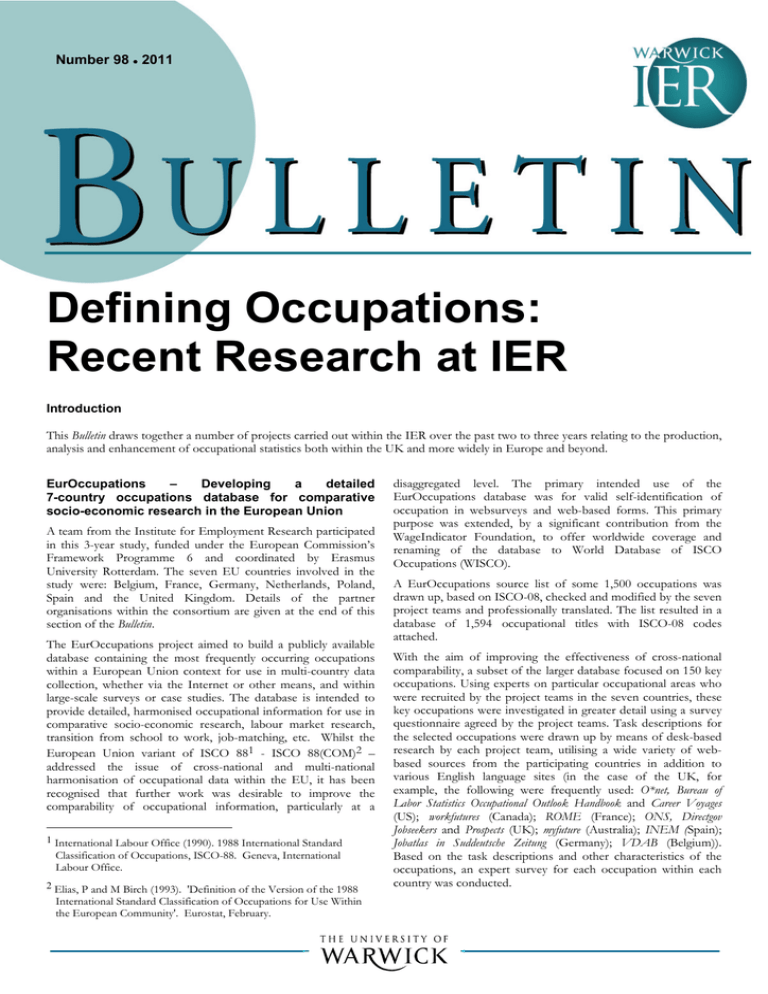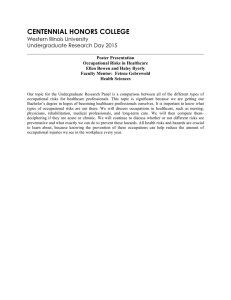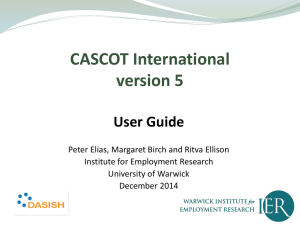Defining Occupations: Recent Research at IER Number 98 2011
advertisement

Number 98 2011 Defining Occupations: Recent Research at IER Introduction This Bulletin draws together a number of projects carried out within the IER over the past two to three years relating to the production, analysis and enhancement of occupational statistics both within the UK and more widely in Europe and beyond. EurOccupations – Developing a detailed 7-country occupations database for comparative socio-economic research in the European Union A team from the Institute for Employment Research participated in this 3-year study, funded under the European Commission’s Framework Programme 6 and coordinated by Erasmus University Rotterdam. The seven EU countries involved in the study were: Belgium, France, Germany, Netherlands, Poland, Spain and the United Kingdom. Details of the partner organisations within the consortium are given at the end of this section of the Bulletin. The EurOccupations project aimed to build a publicly available database containing the most frequently occurring occupations within a European Union context for use in multi-country data collection, whether via the Internet or other means, and within large-scale surveys or case studies. The database is intended to provide detailed, harmonised occupational information for use in comparative socio-economic research, labour market research, transition from school to work, job-matching, etc. Whilst the European Union variant of ISCO 881 - ISCO 88(COM)2 – addressed the issue of cross-national and multi-national harmonisation of occupational data within the EU, it has been recognised that further work was desirable to improve the comparability of occupational information, particularly at a 1 International Labour Office (1990). 1988 International Standard Classification of Occupations, ISCO-88. Geneva, International Labour Office. 2 Elias, P and M Birch (1993). 'Definition of the Version of the 1988 International Standard Classification of Occupations for Use Within the European Community'. Eurostat, February. disaggregated level. The primary intended use of the EurOccupations database was for valid self-identification of occupation in websurveys and web-based forms. This primary purpose was extended, by a significant contribution from the WageIndicator Foundation, to offer worldwide coverage and renaming of the database to World Database of ISCO Occupations (WISCO). A EurOccupations source list of some 1,500 occupations was drawn up, based on ISCO-08, checked and modified by the seven project teams and professionally translated. The list resulted in a database of 1,594 occupational titles with ISCO-08 codes attached. With the aim of improving the effectiveness of cross-national comparability, a subset of the larger database focused on 150 key occupations. Using experts on particular occupational areas who were recruited by the project teams in the seven countries, these key occupations were investigated in greater detail using a survey questionnaire agreed by the project teams. Task descriptions for the selected occupations were drawn up by means of desk-based research by each project team, utilising a wide variety of webbased sources from the participating countries in addition to various English language sites (in the case of the UK, for example, the following were frequently used: O*net, Bureau of Labor Statistics Occupational Outlook Handbook and Career Voyages (US); workfutures (Canada); ROME (France); ONS, Directgov Jobseekers and Prospects (UK); myfuture (Australia); INEM (Spain); Jobatlas in Suddeutsche Zeitung (Germany); VDAB (Belgium)). Based on the task descriptions and other characteristics of the occupations, an expert survey for each occupation within each country was conducted. 2 The EurOccupations project has shown that occupational boundaries, tasks and job requirements can be made transparent across countries – a pre-requisite for implementing such initiatives as the European Qualification Framework or for introducing Skill Cards in various branches of industry. Further information about EurOccupations, including the databases, reports and policy briefs, can be found at www.wageindicator.org/main/projects/euroccp/. EurOccupations project coordinator: Kea Tijdens, Erasmus Universiteit Rotterdam, Faculty of Social Sciences, Rotterdam, Netherlands EurOccupations project partners: Judith De Ruijter, Arbeid Opleidingen Consult, Tilburg, NL Tom Vandenbrande, Katholieke Universiteit Leuven, Hoger Instituut voor de Arbeid, Leuven, BE Peter Elias, Institute for Employment Research, University of Warwick, Coventry, GB Marc Van Der Meer, University of Amsterdam, Amsterdam Institute for Advanced Labour Studies (AIAS), Amsterdam, NL Piotr Michon, Posnan University of Economics, Katedra Pracy I Polityki Sponecznej, Poznan, PL Maria Caprile, Fundacio Centre d’Iniciatives I Recerques Europees a la Mediterrania (CIREM) Barcelona Centre, Barcelona, ES Paulien Osse, Stichting Loonwijzer, Amsterdam, NL Sylvie-Anne Meriot, Centre d’Etudes et de Recherches sur les Qualifications (CEREQ), Marseille, FR Anni Weiler, AWWW GmbH (Arbeitswelt Working World), Gottingen, DE The development of CASCOT was supported by the Economic and Social Research Council’s Research Methods Programme. The research programme is directed by Peter Elias. Early development work, which still forms the core of the CASCOT coding engine, was undertaken by Keith Halstead. Rob Jones performed the task of transforming the software into a more generalisable application. The software is in use by many government departments and agencies which produce statistical information (including HMRC, HESA, ONS, GRO (Scotland)) and by survey data agencies (market research companies and non-commercial organisations). Details of two such applications are described in this Bulletin. CASCOT can be purchased from the IER by visiting www.warwick.ac.uk/go/cascot. The licence terms are generous, allowing purchasers to make multiple copies for their use within their organisation at one geographic location. CASCOT can be used free of charge in an online version. Users who wish to code larger volumes of data will find the desktop version more flexible and convenient. Figure 1 below shows a screenshot from CASCOT in use for coding text to the 2000 version of the UK Standard Occupational Classification. CASCOT for EurOccupations The EurOccupations project provided the opportunity for CASCOT to be tested in a variety of European languages. In the process of developing a harmonised database of job titles in various languages (French, German, Polish, Dutch, English, Spanish, Belgian (Dutch) and Belgian (French)) it became clear that potential users of this large database would need a simple way of searching for harmonised job descriptions. CASCOT was adapted for this task, requiring the software to be modified to handle accented characters. A demonstration version of CASCOT for EurOccupations is available on the EurOccupations website (see the link provided in the description of the EurOccupations project, above). CASCOT: Computer Assisted Structure Coding Tool CASCOT is a computer program designed to assist with the process of classifying text to an appropriate code frame. It has wide application in situations where text is captured electronically and is processed into a classification. It is a generalisation of an earlier software prototype also developed by IER staff specifically for occupation coding (CASOC: Computer Assisted Standard Occupational Coding). Unlike its predecessor, CASCOT can support any classification the user wishes to employ. However, most users of the software benefit from the ‘built in’ classifications supplied with the software package. These include: The Standard Occupational Classification (1990 version; 2000 version; 2010 version); The Standard Industrial Classification (1992 version; 2003 version; 2007 version). The software is flexible and operates in a variety of modes. Users may choose to inspect and select each specific case to be coded. Alternatively, they can let the software decide, having set a usergenerated ‘certainty score’ that must be exceeded before automatic coding is allowed. Figure 1 : CASCOT – coding text to SOC2000 3 CASCOT for the Scottish Census of Population The most significant application of CASCOT to date is its selection by the General Register Office (Scotland) (GRO(S)) as the tool for coding both occupation and industry text as collected on census forms and via the internet in the April 2011 Census of Population in Scotland. Computerised coding of census text was first introduced in the 2001 UK Census of Population. Using software developed and maintained by a US contractor, coding proved to be an expensive process. For this reason, GRO(S) contracted a private sector company to carry out all census data processing, which in turn contracted with the IER for coding of occupation and industry text. A special version of CASCOT, tailored for use with web services, was produced. Using information from the Scottish Census Text, the classification files were fine-tuned to provide the optimal balance between processing speed and accuracy. SOC2010: Revision of the Standard Occupational Classification In June 2010 the Office for National Statistics (ONS) published a new edition of the Standard Occupational Classification (SOC2010), developed as a joint collaboration between experts in occupational classification from the Institute for Employment Research and the ONS. This is the second revision of the classification first introduced in 1990 (SOC90) and revised in 2000 (SOC2000). The IER has collaborated with the ONS in all three editions. The new version results from consultations with, and advice from, a wide variety of users and producers of occupational statistics, including employer associations, professional bodies, trades unions, training organisations, academics and national and local government departments and agencies. The revised classification addresses a major problem evident within UK occupational statistics – the high proportion of occupations classified to Major Group 1 – ‘Managers and senior officials’ – compared with most other European countries and the USA. Via close examination of the main tasks and duties performed in a range of occupations classified to this major group in SOC2000 and an associated redefinition of key managerial functions within the Standard Occupational Classification, the subsequent reallocation of numerous job titles from SOC2010 Major Group 1 to other major Groups reduces the size of this major group from 19% to 12.8% of male employment and from 10.8% to 6.3% for female employment (LFS, first quarter, 2007) – see Table 1 below. 213 (Information Professionals). Technology and Telecommunications Nursing occupations have been reclassified from Major Group 3 (Associate professional and technical occupations) to Major Group 2 (Professional occupations). This reflects the growing proportion of nurses with degree level education following the raising of entry requirements: between 1993/94 and 2006/07, the Labour Force Survey indicates that the proportion of young nurses (26-35 years old) with a degree-level qualification rose from 4 per cent to 32 per cent. To improve alignment with the recently revised International Standard Classification of Occupations (ISCO08)3, a number of supervisory unit groups have been added to the classification. These have been defined in areas of work where the role of the supervisor is distinct and is generally regarded as a separate occupational area from the type of work that is being supervised, such as office managers and supervisors, construction and building trades, cleaning and housekeeping, sales and customer service. The overall impact of reclassification from SOC2000 to SOC2010 To gain some indication of the way in which this revision of the Standard Occupational Classification impacts upon the interpretation of trends in the occupational structure of employment in the UK, the 1996/97 winter quarter of the Labour Force Survey was recoded from SOC2000 to SOC2010, comparing this information with similarly recoded data for the 2007 January-March quarter of the Labour Force Survey. The results for males and females separately are shown in Figures 2 (a and b) above and 3 (a and b) below. Significant declines are evident for males and females within major group 1 – the effect of the reclassification of managerial occupations. There is a corresponding increase in the share of employment in major groups 2, 3 and 5 for males. The increase in the share of employment in major group 2 (Professional occupations) for females is largely due to the reallocation of nursing occupations from major group 3. The new classification will be used to code occupational details provided in the forthcoming Census of Population. By 2012 most other sources of occupational information (e.g. registration statistics, national surveys and job vacancy details) will make use of SOC2010. Figure 2a Percentage distribution of male employment in Dec 1996-Feb 1997, SOC2000 and SOC2010 The classification is updated and improved in a number of areas, including information and communication technology occupations; health-related occupations; leisure and travel related jobs; culture, the arts and sports occupations; and the care sector. Occupations associated with information technology (IT) and telecommunications have been subject to rapid change over the past ten years, with significant growth in web-based communications, a sharp increase in web transactions and the application of IT through virtually all sectors of the economy. Extensive consultation with the lead industry body in this area (eskills UK) contributed to changes in the structure of minor group Source: Labour Force Survey (unweighted data) 3 International Labour Office (2011). 2008 International Standard Classification of Occupations, ISCO-08. Geneva, International Labour Office. 4 Figure 2b Percentage distribution of male employment in Jan-Mar 2007, SOC2000 and SOC2010 Source: Labour Force Survey (unweighted data) Figure 3a Percentage distribution of female employment in Dec 1996-Feb 1997, SOC2000 and SOC2010 Source: Labour Force Survey (unweighted data) Figure 3b Percentage distribution of female employment in Jan-Mar 2007, SOC2000 and SOC2010 Source: Labour Force Survey (unweighted data) Evidencing an enhanced occupational structure for the social care, children’s early years and young people’s workforce This small-scale project was commissioned by the Skills for Care and Development (SfC&D) Sector Skills Council and carried out by experts in occupational classification at the IER. The work programme took advantage of resources compiled and knowledge gained by the IER experts in the process of revising the national occupational classification (SOC2010). The aim of the project was to determine whether or not it was possible to enhance basic national occupational statistical information for this sector, thereby providing more detailed and disaggregated statistical information about the social care, children and young people’s workforce in the UK. Following a short feasibility study, information from the Labour Force Surveys (LFS) was used to determine whether a conversion matrix could be applied to national occupational data to generate estimates of occupational sub-structures of interest to SfC&D. Fifteen unit groups of SOC2010 were deemed of interest to the care sector. These are shown in Table 2. Other potential sources of information had been reviewed during the feasibility study in terms of the extent to which they could yield textual information to explore relevant SOC2010 unit groups in more detail. However, the review concluded that the only sources with such potential were LFS text files, which provided text descriptions of job titles, main tasks and duties and, in some instances, required qualifications for the job or qualifications held. These had been recoded by the Office for National Statistics for SOC2010 from the earlier SOC2000. While interesting information emerged across a number of the SOC2010 unit groups studied in terms of the type of care provided (whether to adults, young people or children), the location of the service provided (residential, non-residential or home-based/domiciliary care) and the gender breakdown of workers in the sector, it was clear that, in terms of the high numbers of jobholders, a particular focus should be on SOC2010 unit group 6145 (Care workers and home carers): data from the LFS for the January-March 2007 quarter revealed that the total workforce count for unit group 6145 is greater than the count for all of the remaining 14 unit groups within the care sector. Within unit group 6145, 90 per cent are female, and of these 48 per cent work within a residential care setting, and over 80 per cent of these work in residential care of adults and the elderly. Limited information was available in the LFS text files relating to vocational qualifications. An analysis was conducted for females only (by far the larger group compared with males) for unit groups 6145 and 6146. In part this sought to address the issue of national minimum standards in social care in England that require some 50 per cent of workers within these unit groups to hold a Level 2 or 3 vocational qualification. This exercise yielded limited information, with a disappointing high count of ‘not specified’ responses (though it should be noted that the LFS supplementary question on qualification is not specifically designed to provide details of qualifications but to improve the accuracy of occupational coding). Nonetheless, it is apparent that 57 per cent of females in unit group 6145 and 75 per cent of females in unit group 6146 hold a Level 2 or 3 NVQ, and this is indicative of the extent to which workers in these occupational unit groups perceive the general requirement for qualifications in order to perform the job. As expected, senior care workers were more likely to supply information about relevant qualifications, and less likely to state that the job required no qualifications than care workers and home carers. In order to cast some light on how job titles are evolving within the care sector, a review was undertaken of the usage of job titles within the text files from the January-March 2007 Labour Force Survey for the 15 unit groups under scrutiny. A high percentage of job title records for managerial level unit groups 1184 and 1242 are ambiguous in terms of referencing the care sector. Similarly ambiguous job titles occur in other unit groups (for example, ‘Customer service agent’, ‘Scheme manager’, ‘Team leader’ without further explanation each occur several times in unit group 6144). Within unit group 6145 (Care workers and home carers) the most frequently occurring job titles are ‘Care assistant’ (around 30 per cent of the total), ‘Carer’ (approximately 22 per cent of the total) and ‘Support worker’ or a close variant (15 per cent of the total). The job titles ‘Personal assistant’ and ‘Personal carer’ appear only a handful of times. 5 Table 1: The redefinition of certain SOC2000 managerial occupation in SOC2010 Repositioned to SOC2010 81% 1121 Production managers and directors in manufacturing 7% 2129 Engineering professionals n.e.c. 6% 5 SKILLED TRADES OCCUPATIONS Managers in construction 72% 1122 Production managers and directors in construction (N=659) 23% 2436 Construction project managers and related professionals 3% 5319 Construction and building trades n.e.c. 74% 1131 Financial managers and directors 5% 2424 Business and financial project management professionals 5% 2429 Business, research and administrative professionals n.e.c. 12% 3538 Financial accounts managers Marketing and sales managers 33% 1132 Marketing and sales directors (N=1,101) 4% 2424 Business and financial project management professionals 59% 3545 Sales accounts and business development managers Information and communication technology managers 31% 1136 Information technology and telecommunications directors (N=607) 43% 2133 IT specialist managers 22% 2134 IT project and programme managers Financial institution managers 47% 1150 Financial institution managers and directors (N=413) 12% 2424 Business and financial project management professionals 3% 3533 Insurance underwriters 20% 3538 Financial accounts managers SOC2000 1121 1122 1131 Production works maintenance managers (N=782) Financial managers chartered secretaries and and (N=438) 1132 1136 1151 1152 1163 13% 4123 Bank and post office clerks Office managers 14% 3538 Financial accounts managers (N=587) 65% 4161 Office managers 3% 7220 Customer service managers and supervisors Retail and wholesale managers 87% 1190 Managers and directors in retail and wholesale (N=944) 10% 7130 Sales supervisors Source: Labour Force Survey January – March 2007 (recoded data file) extracted from Economic & Labour Market Review Vol 4 No 7 July 2010 A main conclusion of the project was that questions that generate information on job titles and the associated description of main tasks and duties do not solicit sufficient information to facilitate more detailed disaggregation of the classification codes in SOC2010. Since the questions asked in surveys that provide occupational data are determined by international agreement and are subject to harmonisation across all official statistical sources in the UK, it is not feasible to ask for more detailed information. Nor is there scope for adding additional questions, given the high costs this would impose. Nonetheless, some important observations were made during the course of the investigation. The new classification of occupations (SOC2010) identifies a new unit group – 6146 Senior care workers. Analysis of recoded Labour Force Survey data indicated that identification of this group is workable. The evidence presented in the full report showed that, on average, Senior care workers are more highly qualified than Care workers (unit group 6145). Critically this distinction relies upon the respondent using the word ‘senior’ (or some equivalent) in her/his job title to facilitate accurate coding. Maintaining and classifications developing labour market These projects give some indication of the expertise and knowledge that staff at the Institute for Employment Research bring to the production and analysis of labour market data, both within the UK and more widely across Europe. Standard classifications, harmonised across statistical producers (national statistical offices, survey and census data processing agencies) lie at the heart of much of our detailed analysis of labour markets. By opening up the classification process to producers and users of statistics, researchers gain a better awareness of the quality of the information they are using for analytical purposes and producers gain more control over the cost and quality of the statistical information they are creating. Moreover, the detailed statistical databases built up at the IER in the course of this work give rise to further research possibilities through which analysts can probe the detail of the information underlying coded data. 6 Table 2 : SOC2010 Unit Groups selected for analysis: titles and short descriptions SOC2010 Unit Group Title Unit group descriptions Social services managers and directors plan, organise, direct and co-ordinate the resources necessary to protect the welfare of certain groups within local authorities including children and young people, families under stress, people with disabilities, elderly people and people needing help as a result of illness. Managers and proprietors in this group plan, organise, direct and co-ordinate the resources necessary in the provision and running of residential and day care establishments and domiciliary care services for persons who require specialised care and/or supervision. Social workers provide information, advice and support to those who are socially excluded or are experiencing crisis; they protect the welfare of vulnerable groups including children, young people, people with disabilities, elderly people and people who are mentally or physically ill, and they may specialise in specific areas of work. 1184 Social services managers and directors 1242 Residential, day and domiciliary care managers and proprietors 2442 Social workers 2443 Probation officers Probation officers work to rehabilitate offenders. They supervise, counsel and help them before trial, during any prison or community sentence and on release from prison. 2449 Welfare n.e.c. professionals Workers in this unit group perform a variety of welfare-related professional occupations not elsewhere classified in MINOR GROUP 244: Welfare Professionals. 3231 Youth and workers community 3233 Child and early years officers 3234 Housing officers 3235 Counsellors Youth and community workers provide support to individuals or groups of individuals through a range of activities or services that aim to encourage participation in social and community life and promote personal and social development. Child and early years officers work with babies and with children up to 14 years of age (or 16 for those with special needs), providing support, help and advice to individuals or within a family context. Housing officers assess and address housing needs of particular localities and individuals and oversee the day-to-day management of rented properties belonging to local authorities or housing associations. Jobholders in this unit group provide counselling services to clients with a wide variety of problems by means of assisting them to reach their own resolutions to the difficulties they face. Counsellors may specialise in a particular area or client group or address a wide range of issues. Workers in this unit group provide pastoral care relating to religious denominations, and a variety of welfare-related services including advice on benefits, health, disability and residential care not elsewhere classified in MINOR GROUP 323: Welfare and Housing Associate Professionals. 3239 Welfare and housing associate professionals n.e.c. Officers of nongovernmental organisations Officers of non-governmental organisations perform a variety of administrative and clerical tasks in the running of trade associations, employers’ associations, learned societies, trade unions, charitable organisations and similar bodies. Houseparents and residential wardens are responsible for the care and supervision of children, Houseparents and young offenders and the elderly within residential homes and nurseries, schools or institutions for 6144 residential wardens young offenders. Care workers and home carers attend to the personal needs and comforts of the elderly and the Care workers and home infirm with care and support needs (‘service users’) within residential care establishments, day 6145 carers care establishments or in their own homes. Senior care workers routinely oversee and monitor care workers, care assistants and home carers. They also attend to the personal needs and comforts of the elderly and the infirm with 6146 Senior care workers care and support needs (‘service users’) within residential care establishments, day care establishments or in their own homes. Care escorts accompany and transport adults and children with disability between their places of residence and other destinations and act as chaperones for under 16s engaged in theatrical, 6147 Care escorts television and film productions. Source: Office for National Statistics (2010) Standard occupational Classification 2010. Volume 1: Structure and descriptions of Unit Groups. 4114 Research on Classifications at the IER The IER has a long history of involvement in the development and revision of various labour market-related classifications. In addition to their work to revise the Standard Occupational Classification in 1990, 2000 and 2010, staff at the IER have also been involved in the production of the Standard Industrial Classifications and the International Classification of Status in Employment. The team was also instrumental in contributing to the ILO’s revision of ISCO 88 to create ISCO 08. A new version of the popular classification software, CASCOT, is due to be launched on 6 June 2011. This software will facilitate coding to the most recent UK occupation and industry classifications and will provide the user with greater control over its editing functions. The team currently involved in these activities includes Margaret Birch, Peter Elias and Ritva Ellison. Warwick Festival of Social Sciences http://www2.warwick.ac.uk/fac/soc/festival/ IER will be participating in this year’s Festival of Social Sciences. There will be a range of activities and events across the University of Warwick’s Faculty of Social Sciences between 5th-26th May 2011. Please visit the Festival website for the most up-to-date information. IER’s Bernard Casey will be holding a workshop on ‘Working beyond Retirement Age: what we know and what we don’t know’ and Professor Kate Purcell will be leading a seminar with Professor Mary Fonow (from Arizona State University) on The Feminist PhD: Content, Pedagogy and Career. IER’s PhD students, Daria Luchinskaya and Charikleia Tzanakou will be profiled, together with Kate Purcell’s ESRC Pathfinder project.







